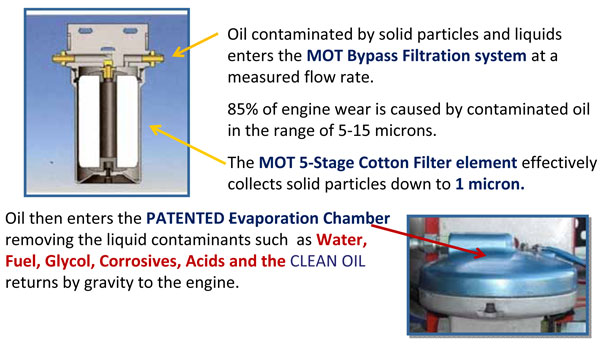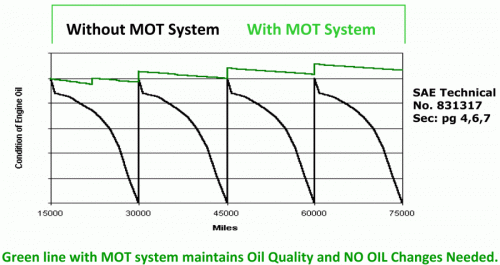Marine Oil Technology
How the Bypass Filtration System for Engine & Hydraulic Oil Works
Oil Contamination
Where do the oil contaminants come from?
By examining the substances in the oil you can find out where in the engine you have a problem.
• Boron (B) – Anti-freeze, fuel with biocides
• Sodium (Na) – Seawater, dust, anti-freeze
• Silicon (Si) – Sand, dust, dirt, glycol-additives
• Barium (Ba) – Oil additives, diesel additives
• Aluminium (Al) – Pistons, bearings, bushings, cylinder liners, dirt, dust
• Chromium (Cr) – Piston rings, cylinder liners, valve lifters, camshaft, anti-freeze
• Copper (Cu) – Bearings, bushings, cooling tubes, copper paste
• Iron (Fe) – Miscellaneous machine parts
• Lead (Pb) – Bearings
• Tin (Sn) – Tin-covered pistons, bearings
• Molybdenum (Mo) – Cylinder liners, piston rings
• Nickel (Ni) – Camshaft, rods
• Titanium (Ti) – Rubber gaskets
• Silver (Ag) – Bearings (needle bearings)
Oil flow and temp
The filter unit and the evaporating unit are built to work as one unit together. To get correct and safe function with the right flow, the oil has to pass through the filter unit before the evaporating unit. The process is driven entirely by the engine’s oil pressure and normal electrical system.
What about Additives?
The oil analysis reveals the amount of additives in the oil sample. A decline of 20% is generally accepted. The following substances are normally included in oil additives:
• Barium (Ba)
• Boron (B)
• Calcium (Ca)
• Magnesium (Mg)
• Phosphorous (P)
• Zinc (Zn)
Additives enhance specific properties of the oil and can be further categorized into sub-groups,
depending on their respective functions:
• Anti-oxidants
• Rust prohibitors
• Dispergents/Detergents
• Anti-wear additives
• EP-additives (Extreme Pressure)
• Anti-foam additives
• VI improvers (Viscosity index)
• Pour-point depressants
• Flow improvers
How to read an oil analysis
Viscosity by 40ºC and 100ºC
Unit: mm2/s
Limit: A variation of +/- 15% is normally accepted
Viscosity decrease
The oil has been diluted by fuel, the oil viscosity helpers have been broken down or the oil has
been topped up with oil of lower viscosity.
Viscosity increase
Large amounts of soot or other contaminations, oxidation products, water that has caused
emulsion or the oil has been topped up with oil of higher viscosity.
Oil Condition Index (OC)
Unit: Graded 0-40
Gives an indication of how contaminated the oil is. Values of 8-11 are typical for new oils. Up to
28 is acceptable for used oil. Higher values can indicate problems with the status of the oil.
Soot
Unit: Weight%
Level of soot in the oil – most engine manufacturers accept values of up to 2.5%.
TBN/TAN
Unit: mg KOH/g
Total Base Number/Total Acid Number -An acid oil can together with water be very aggressive
and cause corrosion. Most engine manufacturers accept a reduction of TBN by 50%.
Water
Unit: % or ppm
Level of water in the oil
Water in oil should be avoided. Water starts the oxidation process and the oil breaks down. More
than 0.2% water (2000 ppm) should not be accepted.
Fuel
Unit: Normal/Caution/Serious
Degree of fuel dilution in the oil.
Glycol
Unit: Normal/Caution/Serious – degree of glycol dilution in the oil.
Flash Open
Unit: Degrees Celsius
Shows if the oils flammability is higher or lower than the stated temperature:
Limits: >195=normal, 195-180=caution, <180=serious
Dispersancy
Unit: Good/Poor. The ability of the oil to keep (soot) particles floating so that they can be filtered
out when the oil passes the oil-filter.
Quick Links
- How the Bypass Filtration System Works
- Testimonial from Latitude
- Testimonial from Parker | Racor
- Testimonial from TraPac
- MOT Specifications
- Mariner Vessel Ships and Boat Engines
- Shipping Port Facilities
- Electrical Generator Facilities
- Cummins Turbo LNG
Downloads
Fairleigh Enterprises
Marine Oil Brochure
Download
Installation Guide
MOT Generic Install Guide
Download – Part 1
Download – Part 2
Download – Part 3
Download – Part 4
Marine Oil Technology. All rights reserved.


